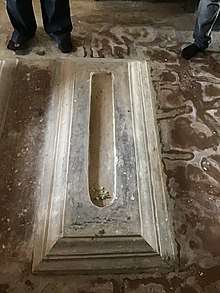Lutfunnisa Begum
Lutfunnisa Begum was the third wife & primary consort of Nawab Siraj ud-Daulah, the last independent Nawab of Bengal.[1]
| Lutfunnisa Begum | |
|---|---|
| Empress of Bengal, Bihar and Odisha | |
 Lutfunissa Begum's tomb in Khosbag | |
| Empress of the Bengal, Bihar and Orissa | |
| Tenure | 9 April 1756 – 23 June 1757 |
| Born | 1740 |
| Died | 10 November 1790 (aged 49–50) Murshidabad, India |
| Burial | Khushbagh, India |
| Spouse | Siraj ud-Daulah |
| Issue | Qudsia Begum Sahiba |
| Religion | Hindu (before marriage) Islam (after marriage) |
Early life
Lutfunnisa was originally named Rajkunwari, she was a Hindu girl who served Begum Sharifun nissa (Siraj's maternal grandmother)[2] Nawab Siraj was infatuated with the beauty of Rajkunwari and asked her grandmother to give her to him. Begum Shorfunnisa gave Rajkunwari to Nawab Siraj, who renamed her Lutfunnisa Begum. Nawab Siraj was already married to his second wife Umdatunnisa Bahu Begum and his first wife was Begum Zaibunissa when he married Lutfunnisa as his third wife.[3][4]
Life after Marriage
Lutfunnisa gave birth to a daughter, Shahzadi Umme Zohra Begum, who was the first born child of Nawab Siraj. In 1748 the father of Nawab Siraj, Zain ud-Din Ahmed Khan the Naib Nazim was killed by Afghan rebels headed by Mustafar Khan. Nawab Siraj was also appointed Naib Nazim of Bihar. During the same time, Lufunnisa Begum became the Primary Consort of Nawab Siraj. After the Battle of Plassey, that saw the British East India Company defeat Nawab Siraj and his French allies, Lutfunnisa escaped the palace with Nawab and their daughter. Accompanying them was a trusted Eunuch. On 24 June 1757 they made their escape. They were soon captured and brought back to Murshidabad by Mir Jafar, the new nawab allied with the British. Mir Qasim, the son in law of Mir Jafar, tortured Lutfunnisa to discover the locations of family jewels.[3]
In 1758, Lutfunnisa and her daughter were exile to Dhaka and imprisoned in Jinjira Palace. She was confined there for seven years during which time Mir Jafar and his son asked her hand in marriage. She refused them both. She was released from Jinjira Palace in 1765 and was allowed back to Murshidabad. The British East India company allowed the creation of a pension for her and her daughter. Her daughter, Shahzadi Umme Zohra Begum, was married to Mir Asad Ali Khan Murad ud Doulah, the nephew of Siraj, son of Mirza Mehedi Ekram ud-Doulah & later nawab of Dhaka. After her marriage, Shahzadi Umme Zohra Begum was renamed as Qudsiyah Begum Sahiba. They would give Lufunnisa four grandsons and daughters, whom she raised after the death of her son-in-law and daughter. In March 1787 she petitioned the British East India Company to increase her pension so to meet the additional cost of four grandchildren. The company refused the increase. The Estate of the Nawab of Bengal still paid for the upkeep of Lufunnisa's father-in-law's grave, which was managed by her.[3][5]
Death
Lufunnisa died in November 10 1790. She was buried in Khushbagh by the side of her husband.[3]
Popular in culture
- Historical soap era Ami Sirajer Begum in 2018-19 at Star Jalsha done by Pallabi Dey
- Ami Sirajer Begam cinema in 1979 done by Sandhya Roy
- Ami Sirajer Begam book by Parabat helps us a better look into her life.
References
- "The women in Siraj ud-Daulah's life". The Daily Star. 4 October 2012. Retrieved 6 November 2017.
- Markovits, Claude (2004). A History of Modern India, 1480-1950. Anthem Press. ISBN 9781843310044.
- Iqbal, Shahryar ZR. "Lutfunnisa Begum". en.banglapedia.org. Banglapedia. Retrieved 6 November 2017.
- Paul, Gautam. "Murshidabad History". murshidabad.net. Retrieved 6 November 2017.
- "Jinjira Palace: A tale lost in time". Prothom Alo. Archived from the original on 7 November 2017. Retrieved 6 November 2017.